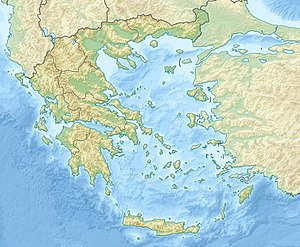
Aegean civilization is a general term for the Bronze Age civilizations of Greece around the Aegean Sea. There are three distinct but communicating and interacting geographic regions covered by this term: Crete, the Cyclades and the Greek mainland. Crete is associated with the Minoan civilization from the Early Bronze Age. The Cycladic civilization converges with the mainland during the Early Helladic ("Minyan") period and with Crete in the Middle Minoan period. From c. 1450 BC, the Greek Mycenaean civilization spreads to Crete, probably by military conquest. The earlier Aegean farming populations of Neolithic Greece brought agriculture westward into Europe before 5,000 BC.

Mycenae is an archaeological site near Mykines in Argolis, north-eastern Peloponnese, Greece. It is located about 120 kilometres south-west of Athens; 11 kilometres north of Argos; and 48 kilometres south of Corinth. The site is 19 kilometres inland from the Saronic Gulf and built upon a hill rising 900 feet above sea level.

Tiryns is a Mycenaean archaeological site in Argolis in the Peloponnese, and the location from which the mythical hero Heracles was said to have performed his Twelve Labours. It lies 20 km (12 mi) south of Mycenae.

Mycenaean Greece was the last phase of the Bronze Age in ancient Greece, spanning the period from approximately 1750 to 1050 BC. It represents the first advanced and distinctively Greek civilization in mainland Greece with its palatial states, urban organization, works of art, and writing system. The Mycenaeans were mainland Greek peoples who were likely stimulated by their contact with insular Minoan Crete and other Mediterranean cultures to develop a more sophisticated sociopolitical culture of their own. The most prominent site was Mycenae, after which the culture of this era is named. Other centers of power that emerged included Pylos, Tiryns, and Midea in the Peloponnese, Orchomenos, Thebes, and Athens in Central Greece, and Iolcos in Thessaly. Mycenaean settlements also appeared in Epirus, Macedonia, on islands in the Aegean Sea, on the south-west coast of Asia Minor, and on Cyprus, while Mycenaean-influenced settlements appeared in the Levant and Italy.

A shaft tomb or shaft grave is a type of deep rectangular burial structure, similar in shape to the much shallower cist grave, containing a floor of pebbles, walls of rubble masonry, and a roof constructed of wooden planks.

The Treasury of Atreus or Tomb of Agamemnon is a large tholos or beehive tomb constructed between 1300 and 1250 BCE in Mycenae, Greece.

Helladic chronology is a relative dating system used in archaeology and art history. It complements the Minoan chronology scheme devised by Sir Arthur Evans for the categorisation of Bronze Age artefacts from the Minoan civilization within a historical framework. Whereas Minoan chronology is specific to Crete, the cultural and geographical scope of Helladic chronology is confined to mainland Greece during the same timespan. Similarly, a Cycladic chronology system is used for artifacts found in the Aegean islands. Archaeological evidence has shown that, broadly, civilisation developed concurrently across the whole region and so the three schemes complement each other chronologically. They are grouped together as "Aegean" in terms such as Aegean art and, rather more controversially, Aegean civilization.

The Mask of Agamemnon is a gold funerary mask discovered at the Bronze Age site of Mycenae in southern Greece. The mask, displayed in the National Archaeological Museum of Athens, has been described by the historian Cathy Gere as the "Mona Lisa of prehistory".
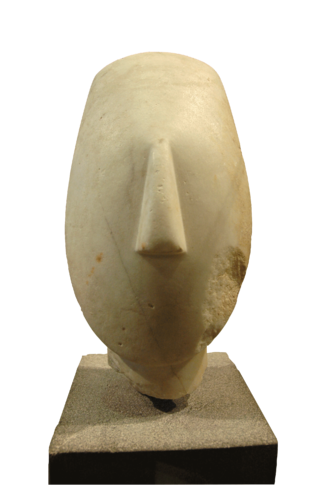
Aegean art is art that was created in the lands surrounding, and the islands within, the Aegean Sea during the Bronze Age, that is, until the 11th century BC, before Ancient Greek art. Because is it mostly found in the territory of modern Greece, it is sometimes called Greek Bronze Age art, though it includes not just the art of the Mycenaean Greeks, but also that of the Cycladic and Minoan cultures, which converged over time.
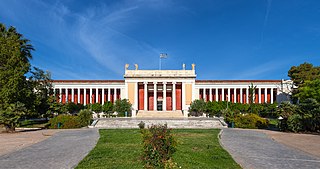
The National Archaeological Museum in Athens houses some of the most important artifacts from a variety of archaeological locations around Greece from prehistory to late antiquity. It is considered one of the greatest museums in the world and contains the richest collection of Greek Antiquity artifacts worldwide. It is situated in the Exarcheia area in central Athens between Epirus Street, Bouboulinas Street and Tositsas Street while its entrance is on the Patission Street adjacent to the historical building of the Athens Polytechnic university.

Christos Tsountas was a Greek classical archaeologist. He is considered a pioneer of Greek archaeology and has been called "the first and most eminent Greek prehistorian".
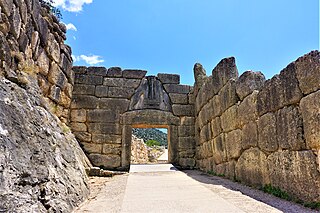
Lion Gate is the popular modern name for the main entrance of the Bronze Age citadel of Mycenae in southern Greece. It was erected during the thirteenth century BC, around 1250 BC, in the northwestern side of the acropolis. In modern times, it was named after the relief sculpture of two lionesses in a heraldic pose that stands above the entrance.

Bush Barrow is a site of the early British Bronze Age Wessex culture, at the western end of the Normanton Down Barrows cemetery in Wiltshire, England. It is among the most important sites of the Stonehenge complex, having produced some of the most spectacular grave goods in Britain. It was excavated in 1808 by William Cunnington for Sir Richard Colt Hoare. The finds, including worked gold objects, are displayed at Wiltshire Museum in Devizes.

Mycenaean pottery is the pottery tradition associated with the Mycenaean period in Ancient Greece. It encompassed a variety of styles and forms including the stirrup jar. The term "Mycenaean" comes from the site Mycenae, and was first applied by Heinrich Schliemann.

Grave Circle B in Mycenae is a 17th–16th century BCE royal cemetery situated outside the late Bronze Age citadel of Mycenae, southern Greece. This burial complex was constructed outside the fortification walls of Mycenae and together with Grave Circle A represent one of the major characteristics of the early phase of the Mycenaean civilization.

The Tomb of Clytemnestra was a Mycenaean tholos type tomb built in c. 1250 BC. A number of architectural features such as the semi-column were largely adopted by later classical monuments of the first millennium BC, both in the Greek and Latin world. The Tomb of Clytemnestra with its imposing façade is together with the Treasury of Atreus the most monumental tomb of that type.
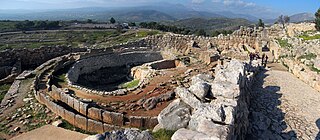
There have been many discoveries of gold grave goods at Grave Circles A and B in the Bronze Age city of Mycenae. Gold has always been used to show status amongst the deceased when used in grave goods. While there's evidence that the practice of grave goods and monumentalizing graves to show status was used throughout Ancient Greece from the Bronze Age and passed through the Classical Period, the goods themselves changed over time. However, using gold as a material was a constant status marker. At the Grave Circles in Mycenae, there were several grave goods found that were made out of gold; masks, cups, swords, jewelry, and more. Because there were so many gold grave goods found at this site there's a legend of Golden Mycenae. Each family group would add ostentatious grave goods to compete with the other family groups for who is the wealthiest. There was more gold found at Grave Circle A and B than in all of Crete before the late Bronze Age.

Mycenae is a city in the Argolid, in the Peloponnese peninsula of Greece. It was first excavated by Heinrich and Sophia Schliemann in the 1870s and is believed to have flourished in the Mid- to Late Bronze Age. The fortifications of Mycenae were built with the use of Cyclopean masonry. With the citadel built on a cliff, the architects created protection not only for the upper class that lived within the walls, but the lower-class farmers in the surrounding areas, who could find refuge there in times of war. Due to high competition in the Mid to Late Bronze Age, the citadel wall expanded significantly with the inclusion of Grave Circle A and the addition of the Lion Gate.

The death masks of Mycenae are a series of golden funerary masks found on buried bodies within a burial site titled Grave Circle A, located within the ancient Greek city of Mycenae. There are seven discovered masks in total, found with the burials of six adult males and one male child. There were no women who had masks. They were discovered by Heinrich Schliemann during his 1876 excavation of Mycenae.

The Tomb of Aegisthus is a Mycenaean tholos tomb located near the citadel of Mycenae, Greece. It was constructed in the Late Helladic IIA period, approximately 1510–1450 BCE, and rediscovered in the 19th century. It was first excavated by Winifred Lamb in 1922, as part of a project led by Alan Wace.

